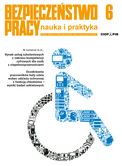Practical aspects of application of the respiratory protection equipment against biological hazards. Legal regulations and survey research analysis
Katarzyna Majchrzycka, Małgorzata Okrasa
The occurrence of biological hazards in the work and life environment often necessitates the use of appropriate respiratory protection equipment. This requires knowledge of both the basic issues arising from EU legislation and the specificity of the selection of this equipment, taking into account its protection class and the time of its safe use. In this regard, a widely available and easy-to-use mobile application will be helpful, as it was designed for the selection and monitoring of the duration of use of respiratory protection equipment by individual users. The article describes in a synthetic way the basic legal requirements for respiratory protective equipment and the results of surveys regarding the experiences of users of such equipment and their expectations as to the functionality of the application. General assumptions for the development of the application were also presented.
DOI: 10.5604/01.3001.0015.2296
Characteristics of OSH services in Poland – research results
Magdalena Dobrzyńska
The article presents selected results of the study entitled “Diagnosis and prognosis of OSH services and a characterization of OSH professionals” carried out in 2020. The study included telephone questionnaire interviews on a sample of 500 representatives of the in-house OSH service and OSH specialists from outside a workplace. The article focuses on the results concerning: the structure of the health and safety service, conditions for entering the profession and professional promotion, as well as employment conditions, sources of satisfaction and professional difficulties.
DOI: 10.5604/01.3001.0015.2297
OSH-related innovations Polish enterprises during the COVID-19 epidemic
Małgorzata Pęciłło
The concept of innovation means, according to OECD definition, implementation of a new or significantly improved product, service or method, e.g. of management. The article presents the level of implementation of organisational innovations in Poland in comparison to other countries. In the light of these statistics Poland takes one of the worst places in terms of innovativeness. Meanwhile, innovativeness may also be indicated by the ability to react quickly to changes in the company's closer and further environment and to quickly implement previously unused methods and work organisation in order to ensure continuity of operations. Such skills were demonstrated by Polish enterprises in the face of the COVID-19 outbreak.
DOI: 10.5604/01.3001.0015.2298
Methods of occupational risk assessment related to the use of nanomaterials
Małgorzata Pośniak
The use of nanomaterials in the different areas of the national economy, on one hand, contributes to the manufacture of products that make human life easier and more comfortable, but on the other, if the risk is not properly managed, it can pose a threat to the workers' health. Therefore, it is necessary to identify, assess and reduce the risk of occupational exposure to these hazardous materials. Presented in the article methods for estimation of the occupational risk are now the sole solution to properly manage the risk posed by engineering nanomaterials (ENMs) and to take appropriate measures to reduce it. Their application will enable Polish employers to comply with the recommendations of Directive 98/24 EC in the area of occupational risk management related to these specific chemical substances.
The main means to solving the problem of occupational risk assessment, posed by nanomaterials, are control banding methods (CB methods), that take into account the physicochemical properties and specific impact of nanoparticles on living organisms. These methods are increasingly used in EU countries, in the USA and Canada, and are recommended by the International Labour Organisation, the World Health Organisation and the European Agency for Safety and Health at Work.
DOI: 10.5604/01.3001.0015.2299





























